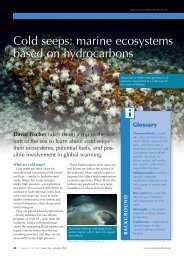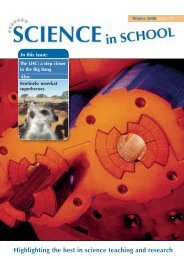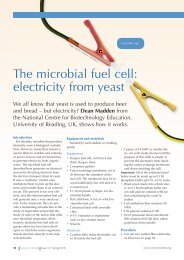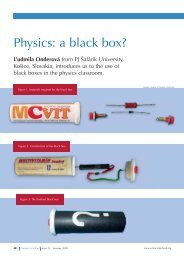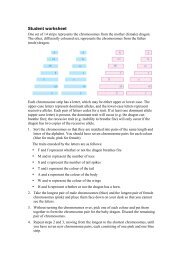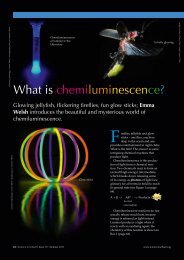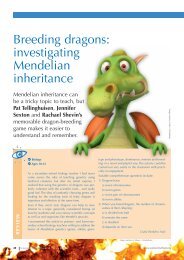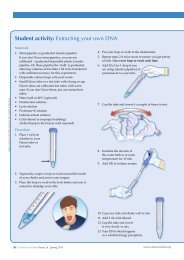Materials science to the rescue: easily ... - Science in School
Materials science to the rescue: easily ... - Science in School
Materials science to the rescue: easily ... - Science in School
Create successful ePaper yourself
Turn your PDF publications into a flip-book with our unique Google optimized e-Paper software.
<strong>Materials</strong> <strong>science</strong> <strong>to</strong> <strong>the</strong><br />
<strong>rescue</strong>: <strong>easily</strong> removable<br />
chew<strong>in</strong>g gum<br />
Hal<strong>in</strong>a Stanley <strong>in</strong>vestigates <strong>the</strong> his<strong>to</strong>ry of<br />
chew<strong>in</strong>g gum, how <strong>the</strong> chemistry of <strong>the</strong><br />
gum affects its properties, and how<br />
scientists are us<strong>in</strong>g this knowledge <strong>to</strong><br />
make chew<strong>in</strong>g gum less of a pollutant.<br />
Image courtesy of iS<strong>to</strong>ckpho<strong>to</strong><br />
56 <strong>Science</strong> <strong>in</strong> <strong>School</strong> Issue 9 : Autumn 2008<br />
www.<strong>science</strong><strong>in</strong>school.org
<strong>Science</strong> <strong>to</strong>pics<br />
Love it or hate it, chew<strong>in</strong>g gum is<br />
a ubiqui<strong>to</strong>us and usually benign<br />
activity. Benign, that is, until some<br />
idiot decides <strong>to</strong> put some <strong>in</strong> your hair.<br />
Wouldn’t it be nice if gum didn’t stick<br />
<strong>to</strong> carpets, shoes and <strong>the</strong> underside of<br />
school desks? Terry Cosgrove, professor<br />
of chemistry at Bris<strong>to</strong>l University,<br />
UK, has decided <strong>to</strong> take action; his<br />
<strong>easily</strong> removable chew<strong>in</strong>g gum may<br />
save millions <strong>in</strong> clean<strong>in</strong>g bills w1 .<br />
The stick<strong>in</strong>ess of chew<strong>in</strong>g gum may<br />
be an unwanted side-effect w2 , but<br />
chew<strong>in</strong>ess is a very desirable property.<br />
Manufacturers of chew<strong>in</strong>g gum –<br />
and old wives’ tales – suggest that<br />
chew<strong>in</strong>g gum can be helpful for<br />
improv<strong>in</strong>g focus, concentration and<br />
alertness, reduc<strong>in</strong>g stress, and<br />
enhanc<strong>in</strong>g weight loss; we now even<br />
have versions that help us s<strong>to</strong>p smok<strong>in</strong>g<br />
and prevent seasickness. There<br />
are even market<strong>in</strong>g claims that chew<strong>in</strong>g<br />
gum can significantly reduce<br />
<strong>to</strong>oth decay and bad breath. However,<br />
a ‘scientific’ survey of two highschool<br />
students, carried out by <strong>the</strong><br />
author, suggests that children actually<br />
chew gum as a displacement activity<br />
for pen and pencil chew<strong>in</strong>g: chew<strong>in</strong>g<br />
appears <strong>to</strong> be a universal human<br />
need.<br />
So what is chew<strong>in</strong>g gum?<br />
His<strong>to</strong>rically it was simply res<strong>in</strong> bled<br />
from trees. For example, <strong>in</strong> <strong>the</strong><br />
Yucatan Pen<strong>in</strong>sula <strong>in</strong> Central<br />
America, Amer<strong>in</strong>dians (native<br />
Americans) extracted gum from a<br />
tropical evergreen tree called <strong>the</strong><br />
Manilkara chicle. More than a thousand<br />
years ago, <strong>the</strong>y made gashes <strong>in</strong><br />
<strong>the</strong> trunk, collected <strong>the</strong> drips of gum<br />
and <strong>the</strong>n heated it until it reached a<br />
useful consistency for chew<strong>in</strong>g. The<br />
word ‘chicle’ even means ‘sticky stuff’<br />
<strong>in</strong> <strong>the</strong> ancient Nahuatl Aztec language.<br />
But chew<strong>in</strong>g gum is not – even<br />
orig<strong>in</strong>ally – a purely American habit:<br />
European S<strong>to</strong>ne-Age people also used<br />
<strong>to</strong> chew gum. In 2007, Sarah Pick<strong>in</strong><br />
from <strong>the</strong> University of Derby, UK,<br />
found a 5000-year-old piece of gum,<br />
complete with fossilised <strong>to</strong>oth marks,<br />
while on an archaeological dig <strong>in</strong><br />
F<strong>in</strong>land w3 . This gum was extracted<br />
from birch trees by S<strong>to</strong>ne-Age people<br />
and heated <strong>to</strong> form a k<strong>in</strong>d of tar<br />
which would have been solid when<br />
cold, but softer if warmed. It seems<br />
that it was used as glue for repair<strong>in</strong>g<br />
cook<strong>in</strong>g pots or for stick<strong>in</strong>g arrowheads<br />
on<strong>to</strong> <strong>the</strong>ir shafts, but clearly it<br />
was also chewed. Professor Trevor<br />
Brown, Sarah’s tu<strong>to</strong>r at <strong>the</strong> University<br />
of Derby, says that this gum conta<strong>in</strong>s<br />
natural antiseptic compounds, so<br />
Neolithic people would have had<br />
<strong>the</strong>ir own medicated chew<strong>in</strong>g gum <strong>to</strong><br />
treat mouth <strong>in</strong>fections.<br />
Chicle, and o<strong>the</strong>r tree saps – <strong>in</strong>clud<strong>in</strong>g<br />
latex, from which natural rubber<br />
Manilkara chicle tree<br />
can be produced – are natural polymers.<br />
These polymers – polyterpenes<br />
– are composed of thousands of C 5 H 8<br />
isoprene subunits w4 . Depend<strong>in</strong>g on<br />
<strong>the</strong> species of tree or plant, <strong>the</strong> natural<br />
polymers may be more or less<br />
highly branched, have differ<strong>in</strong>g sizes<br />
(molecular weight) and may be mixed<br />
with volatile essential oils, all of<br />
which lead <strong>to</strong> differ<strong>in</strong>g softnesses and<br />
elasticities. (The effects of <strong>the</strong> chemical<br />
structure on <strong>the</strong> physical properties<br />
of polymers can be readily <strong>in</strong>vestigated<br />
<strong>in</strong> <strong>the</strong> classroom w5 .) These viscous<br />
liquids can be solidified by <strong>in</strong>troduc<strong>in</strong>g<br />
cross-l<strong>in</strong>ks <strong>in</strong><strong>to</strong> <strong>the</strong> polymers;<br />
this process can be <strong>in</strong>vestigated by<br />
add<strong>in</strong>g sodium tetraborate solution <strong>to</strong><br />
Public doma<strong>in</strong> image; image source:<br />
Wikimedia Commons<br />
www.<strong>science</strong><strong>in</strong>school.org <strong>Science</strong> <strong>in</strong> <strong>School</strong> Issue 9 : Autumn 2008 57
Adhesion<br />
BACKGROUND<br />
There<br />
·<br />
are many ways <strong>in</strong> which th<strong>in</strong>gs stick. These <strong>in</strong>clude:<br />
Mechanical <strong>in</strong>terlock<strong>in</strong>g, such as occurs with Velcro or glues that flow <strong>in</strong><strong>to</strong> cracks and crevices of <strong>the</strong> substrate<br />
and <strong>the</strong>n harden, physically lock<strong>in</strong>g on <strong>to</strong> <strong>the</strong> substrate.<br />
· Intermolecular attractions (e.g. hydrogen bonds and Van der Waals forces). Geckos are renowned for scamper<strong>in</strong>g<br />
up smooth vertical walls (even glass). Each of <strong>the</strong>ir feet is covered <strong>in</strong> nearly 500 000 hairs, which<br />
adhere <strong>to</strong> surfaces via weak Van der Waals forces (Autumn et al, 2000). The adhesion of a gecko’s foot <strong>to</strong> <strong>the</strong><br />
wall needs <strong>to</strong> be reversible (imag<strong>in</strong>e <strong>the</strong> poor gecko if it were not), so this is a good strategy: <strong>the</strong> forces are<br />
weak but <strong>the</strong> cumulative effect of 500 000 hairs is not; by peel<strong>in</strong>g its foot off <strong>the</strong> surface, <strong>the</strong> gecko can break<br />
·<br />
<strong>the</strong> forces bit by bit.<br />
The formation of chemical bonds (covalent or ionic bond formation). Mussels, which unlike geckos are not<br />
very mobile creatures, stick firmly <strong>to</strong> rocks <strong>in</strong> s<strong>to</strong>rmy wea<strong>the</strong>r us<strong>in</strong>g ra<strong>the</strong>r stronger covalent bonds. And some<br />
·<br />
glues form covalent or ionic bonds with surfaces, although <strong>the</strong> exact details tend <strong>to</strong> be commercial secrets.<br />
Interdiffusion at <strong>the</strong> <strong>in</strong>terface. This generally leads <strong>to</strong> very strong adhesion, s<strong>in</strong>ce <strong>the</strong> two materials are mixed<br />
at a molecular level. Many materials <strong>in</strong>terdiffuse <strong>to</strong> some extent – two similar polymers at a moderate temperature<br />
will <strong>in</strong>terdiffuse, and <strong>the</strong> process is important <strong>in</strong> metal-metal contacts and metal-metal oxides.<br />
· Electrostatic attractions. Researchers at <strong>the</strong> US National Institute of Standards and Technology (NIST) are<br />
currently exam<strong>in</strong><strong>in</strong>g <strong>the</strong> possibility of us<strong>in</strong>g electrostatic charges <strong>to</strong> bond semiconduc<strong>to</strong>rs.<br />
polyv<strong>in</strong>ylalcohol ‘white’ glue.<br />
Worksheets for this classic experiment<br />
can be found on a number of<br />
websites w6 and it is <strong>in</strong>terest<strong>in</strong>g <strong>to</strong><br />
observe <strong>the</strong> effect of vary<strong>in</strong>g crossl<strong>in</strong>k<br />
density (by chang<strong>in</strong>g <strong>the</strong> ratio of<br />
sodium tetraborate <strong>to</strong> glue).<br />
Although <strong>the</strong> first chew<strong>in</strong>g-gum<br />
fac<strong>to</strong>ry, which opened <strong>in</strong> <strong>the</strong> USA <strong>in</strong><br />
1870, used sap from <strong>the</strong> Manilkara<br />
chicle tree as its gum base, modern<br />
chew<strong>in</strong>g gums use syn<strong>the</strong>tic polymers.<br />
With consumption of gum at a<br />
stagger<strong>in</strong>g 50 billion sticks a year <strong>in</strong><br />
<strong>the</strong> USA alone (around 170 sticks per<br />
capita per year), rely<strong>in</strong>g solely on<br />
tropical forests <strong>to</strong> supply <strong>the</strong> raw<br />
material is not a viable option. Some<br />
formulations may still <strong>in</strong>clude natural<br />
<strong>in</strong>gredients but data are hard <strong>to</strong> come<br />
by – <strong>the</strong>se are closely guarded commercial<br />
secrets. Instead, <strong>the</strong> syn<strong>the</strong>tic<br />
polymer gum bases used <strong>in</strong> commercial<br />
chew<strong>in</strong>g gum mimic and optimise<br />
<strong>the</strong> properties of <strong>the</strong> natural polymers:<br />
<strong>the</strong>y are <strong>in</strong>ert, <strong>in</strong>soluble and<br />
entirely non-nutritive. These polymers<br />
are syn<strong>the</strong>sised from petroleum<br />
products <strong>to</strong> which sugar (or a sweetener<br />
such as aspartame) and o<strong>the</strong>r<br />
flavour<strong>in</strong>gs are added. Colour<strong>in</strong>g (traditionally<br />
bright p<strong>in</strong>k for bubblegum)<br />
is <strong>the</strong> only additional <strong>in</strong>gredient,<br />
unless <strong>the</strong> gum is <strong>to</strong> be used <strong>in</strong> a<br />
medical application, for example <strong>to</strong><br />
help quit smok<strong>in</strong>g, s<strong>in</strong>ce <strong>the</strong>se gums<br />
obviously also conta<strong>in</strong> a drug (e.g.<br />
nicot<strong>in</strong>e) <strong>in</strong> a water-soluble form.<br />
The formulation of gum base, so<br />
that it gives <strong>the</strong> right chew<strong>in</strong>ess (elasticity)<br />
and flavour release, is complex<br />
and varies depend<strong>in</strong>g on <strong>the</strong> desired<br />
elastic properties (bubblegum is more<br />
elastic than ord<strong>in</strong>ary chew<strong>in</strong>g gum,<br />
for example). It conta<strong>in</strong>s various elas<strong>to</strong>mers<br />
(<strong>to</strong> provide <strong>the</strong> elasticity),<br />
res<strong>in</strong>s (that act as b<strong>in</strong>ders), fillers (that<br />
contribute <strong>to</strong> overall texture and may<br />
help create low-calorie gums by bulk<strong>in</strong>g<br />
<strong>the</strong> gum up without add<strong>in</strong>g nutritive<br />
<strong>in</strong>gredients) and plasticisers (<strong>to</strong><br />
soften <strong>the</strong> mixture) w7 . The ma<strong>in</strong> component<br />
is typically a mixture of syn<strong>the</strong>tic<br />
elas<strong>to</strong>mers such as polyiso -<br />
butylene, isobutylene-isoprene copolymers<br />
(butyl rubber), styrenebutadiene<br />
co-polymers and poly -<br />
v<strong>in</strong>ylacetate – you may have heard of<br />
some of <strong>the</strong>se <strong>in</strong> connection with car<br />
tyres. These polymers are all <strong>in</strong>soluble<br />
<strong>in</strong> water, hydrophobic (water-hat<strong>in</strong>g)<br />
and non-biodegradable. This expla<strong>in</strong>s<br />
why scrubb<strong>in</strong>g your carpet with<br />
water doesn’t shift chew<strong>in</strong>g gum.<br />
Soak<strong>in</strong>g <strong>in</strong> water won’t help ei<strong>the</strong>r.<br />
And if <strong>the</strong> gum is stuck <strong>to</strong> a concrete<br />
wall or pav<strong>in</strong>g s<strong>to</strong>ne, ra<strong>in</strong> won’t wash<br />
it away.<br />
When a stick of gum is chewed, <strong>the</strong><br />
water-soluble part (sugar and flavour<strong>in</strong>gs)<br />
is gradually released, while <strong>the</strong><br />
polymer base (<strong>the</strong> plastic) rema<strong>in</strong>s.<br />
After a while, <strong>the</strong> gum becomes tasteless<br />
because all <strong>the</strong> flavour<strong>in</strong>gs have<br />
been released; <strong>the</strong> gum base never<br />
dissolves away. The warmth of <strong>the</strong><br />
mouth softens <strong>the</strong> gum base and<br />
makes it more pliable, but it isn’t real-<br />
58<br />
<strong>Science</strong> <strong>in</strong> <strong>School</strong> Issue 9 : Autumn 2008<br />
www.<strong>science</strong><strong>in</strong>school.org
<strong>Science</strong> <strong>to</strong>pics<br />
ly changed and will harden aga<strong>in</strong> on cool<strong>in</strong>g (although<br />
it may become somewhat <strong>to</strong>ugher if any plasticisers are<br />
released). To blow <strong>the</strong> best bubbles, chew until all <strong>the</strong><br />
sugar has been released and only <strong>the</strong> stretchy polymer<br />
base is left: sugar is not a polymer, doesn’t stretch, and<br />
can cause bubbles <strong>to</strong> collapse prematurely.<br />
So <strong>to</strong> return <strong>to</strong> <strong>the</strong> orig<strong>in</strong>al question: why does chew<strong>in</strong>g<br />
gum stick so well <strong>to</strong> most surfaces? The <strong>science</strong> of<br />
adhesion is complicated (see box) and <strong>in</strong> <strong>the</strong> case of<br />
chew<strong>in</strong>g gum, probably <strong>in</strong>volves both mechanical<br />
effects and chemical bonds. However, whatever <strong>the</strong><br />
stick<strong>in</strong>g mechanism, <strong>the</strong> two surfaces must be <strong>in</strong> very<br />
close contact, <strong>to</strong> ‘wet’ each o<strong>the</strong>r (‘wett<strong>in</strong>g’ describes <strong>the</strong><br />
contact between a liquid and a solid surface, result<strong>in</strong>g<br />
from <strong>in</strong>termolecular <strong>in</strong>teractions) before <strong>the</strong>y will<br />
adhere. Soft chew<strong>in</strong>g gum fits <strong>the</strong> bill perfectly. And<br />
once it is stuck, <strong>the</strong> energy that you put <strong>in</strong><strong>to</strong> pull<strong>in</strong>g it<br />
doesn’t go <strong>in</strong><strong>to</strong> break<strong>in</strong>g <strong>the</strong> bonds hold<strong>in</strong>g <strong>the</strong> gum <strong>to</strong><br />
<strong>the</strong> surface (as you would like); <strong>in</strong>stead, you just stretch<br />
and slide <strong>the</strong> polymer molecules <strong>in</strong> <strong>the</strong> gum. This is a<br />
general property of polymers (above a certa<strong>in</strong> temperature):<br />
<strong>the</strong> long tangled molecules tend <strong>to</strong> have lots of<br />
bends that can be straightened a little by pull<strong>in</strong>g on<br />
<strong>the</strong>m. (You can demonstrate <strong>the</strong> stretch<strong>in</strong>g of polymers<br />
<strong>in</strong> <strong>the</strong> classroom us<strong>in</strong>g poly<strong>the</strong>ne bags w8 ). So how does<br />
this knowledge help us make chew<strong>in</strong>g gum that is less<br />
sticky?<br />
Reduc<strong>in</strong>g <strong>the</strong> stretch<strong>in</strong>ess of chew<strong>in</strong>g gum is not a<br />
sensible strategy: who would want <strong>to</strong> chew a bouncy<br />
ball? Instead, Professor Cosgrove has <strong>in</strong>corporated a<br />
hydrophilic (water-lov<strong>in</strong>g) polymer <strong>in</strong><strong>to</strong> <strong>the</strong> gum base.<br />
When <strong>the</strong> gum is chewed, <strong>the</strong> hydrophilic polymer<br />
absorbs saliva and softens <strong>the</strong> gum. It also migrates <strong>to</strong><br />
<strong>the</strong> surface. This means that <strong>the</strong>re is always a th<strong>in</strong> film<br />
of water on <strong>the</strong> surface of <strong>the</strong> wad of chew<strong>in</strong>g gum<br />
after chew<strong>in</strong>g. This persistent film of water ends up<br />
between <strong>the</strong> gum and any surface, prevent<strong>in</strong>g close<br />
contact and prevent<strong>in</strong>g <strong>the</strong> gum stick<strong>in</strong>g. Simple? Not<br />
really. If a hydrophilic polymer were simply added, it<br />
wouldn’t mix with <strong>the</strong> gum base (just as you can’t mix<br />
oil and water). Instead, a co-polymer (a polymer made<br />
of two types of monomers, or build<strong>in</strong>g blocks) that has<br />
both hydrophilic and hydrophobic parts must be used;<br />
even this needs <strong>to</strong> be carefully added <strong>to</strong> avoid phase<br />
separation w9 . Pa<strong>in</strong>t manufacturers use a similar trick:<br />
<strong>the</strong>y mix <strong>the</strong> elas<strong>to</strong>meric polymer(s), which will dry <strong>to</strong><br />
become a water-resistant coat<strong>in</strong>g, with water us<strong>in</strong>g this<br />
k<strong>in</strong>d of co-polymer w10 .<br />
The addition of <strong>the</strong> water-lov<strong>in</strong>g polymer has ano<strong>the</strong>r<br />
benefit. Ord<strong>in</strong>ary chew<strong>in</strong>g gum is pretty resistant <strong>in</strong> <strong>the</strong><br />
environment: it doesn’t dissolve <strong>in</strong> ra<strong>in</strong> and wea<strong>the</strong>r<strong>in</strong>g<br />
Image courtesy of Luis Fernández García, image source: Wikimedia Commons<br />
Manilkara chicle tree with<br />
gashes <strong>to</strong> collect <strong>the</strong> sap<br />
www.<strong>science</strong><strong>in</strong>school.org <strong>Science</strong> <strong>in</strong> <strong>School</strong> Issue 9 : Autumn 2008<br />
59
tends <strong>to</strong> harden it, which makes it a<br />
very persistent pollutant (th<strong>in</strong>k of<br />
those grey blobs on <strong>the</strong> pavement!). In<br />
contrast, <strong>the</strong> gum conta<strong>in</strong><strong>in</strong>g a<br />
hydrophilic polymer (<strong>the</strong> non-stick<br />
variety of chew<strong>in</strong>g gum) slowly dis<strong>in</strong>tegrates<br />
<strong>in</strong> <strong>the</strong> presence of water.<br />
Although <strong>the</strong> co-polymer used <strong>in</strong><br />
non-stick chew<strong>in</strong>g gum has been<br />
patented w11 , <strong>the</strong> team is still perfect<strong>in</strong>g<br />
<strong>the</strong> exact composition of its gum base.<br />
So far <strong>the</strong>y have tested more than 200<br />
different formulations – I understand<br />
Violet Beauregarde was one of <strong>the</strong>ir<br />
first employees (read Charlie and <strong>the</strong><br />
Chocolate Fac<strong>to</strong>ry by Roald Dahl). In<br />
addition <strong>to</strong> <strong>the</strong> usual polymer parameters<br />
of molecular weight, degree of<br />
branch<strong>in</strong>g and cross-l<strong>in</strong>k density, <strong>the</strong><br />
team has <strong>to</strong> optimise <strong>the</strong>ir water-lov<strong>in</strong>g/-hat<strong>in</strong>g<br />
schizophrenic co-polymer.<br />
Too much water-lov<strong>in</strong>g polymer<br />
and <strong>the</strong> gum may be <strong>to</strong>o soft. The<br />
wrong composition and <strong>the</strong> gum may<br />
fall apart <strong>in</strong> <strong>the</strong> mouth or still stick <strong>to</strong><br />
surfaces. The team seems confident<br />
that a product will be ready for market<strong>in</strong>g<br />
<strong>in</strong> <strong>the</strong> near future. I’m keep<strong>in</strong>g<br />
my f<strong>in</strong>gers crossed that it proves popular<br />
– o<strong>the</strong>rwise we’ll just have <strong>to</strong> put<br />
non-stick coat<strong>in</strong>gs on <strong>the</strong> underside of<br />
all <strong>the</strong> school desks!<br />
Acknowledgements<br />
I would like <strong>to</strong> thank Professor<br />
Cosgrove for useful discussions and<br />
for critically read<strong>in</strong>g this manuscript.<br />
References<br />
Autumn K et al (2000) Adhesive force<br />
of a s<strong>in</strong>gle gecko foot-hair. Nature<br />
405: 681-685. doi: 10.1038/35015073.<br />
Download <strong>the</strong> article free of charge<br />
from <strong>the</strong> <strong>Science</strong> <strong>in</strong> <strong>School</strong> website<br />
(www.<strong>science</strong><strong>in</strong>school.org/2008/<br />
issue9/chew<strong>in</strong>ggum) or subscribe<br />
<strong>to</strong> Nature <strong>to</strong>day:<br />
www.nature.com/subscribe<br />
In Roald Dahl’s well-loved children’s<br />
book, Charlie and <strong>the</strong> Chocolate<br />
Fac<strong>to</strong>ry, Violet Beauregarde is a<br />
loathsome child addicted <strong>to</strong> chew<strong>in</strong>g<br />
gum:<br />
Dahl, R (2007 and earlier) Charlie<br />
and <strong>the</strong> Chocolate Fac<strong>to</strong>ry. Puff<strong>in</strong><br />
Books, London, UK. ISBN 978-<br />
0141322711<br />
Image<br />
Web references<br />
w1 – More <strong>in</strong>formation about<br />
Professor Cosgrove’s research is<br />
available on <strong>the</strong> University of<br />
Bris<strong>to</strong>l website:<br />
www.chm.bris.ac.uk/pt/polymer/<br />
<strong>in</strong>troduction.shtml<br />
w2 – An enterta<strong>in</strong><strong>in</strong>g video of<br />
Professor Cosgrove attempt<strong>in</strong>g <strong>to</strong><br />
remove chew<strong>in</strong>g gum from shoes<br />
can be found at<br />
www.revolymer.com<br />
w3 – The s<strong>to</strong>ry of Sarah’s discovery<br />
can be read here:<br />
www.derby.ac.uk/press-office/<br />
news-archive/<br />
heres-a-s<strong>to</strong>ry-<strong>to</strong>-get-your-teeth-<strong>in</strong><strong>to</strong><br />
w4 – To learn about rubber- and<br />
chicle-produc<strong>in</strong>g plants and <strong>the</strong>ir<br />
polymers, see:<br />
http://waynesword.palomar.edu/<br />
ecoph13.htm<br />
http://en.wikipedia.org/wiki/<br />
Chicle<br />
http://en.wikipedia.org/wiki/<br />
Terpene<br />
courtesy of iS<strong>to</strong>ckpho<strong>to</strong><br />
60 <strong>Science</strong> <strong>in</strong> <strong>School</strong> Issue 9 : Autumn 2008<br />
www.<strong>science</strong><strong>in</strong>school.org
<strong>Science</strong> <strong>to</strong>pics<br />
w5 – A great teach<strong>in</strong>g activity about<br />
chang<strong>in</strong>g <strong>the</strong> properties of polymers<br />
and plastics (activity number 3.1.5)<br />
can be downloaded from <strong>the</strong> Royal<br />
Society of Chemistry (UK) website:<br />
www.chemsoc.org/networks/<br />
learnnet/<strong>in</strong>spirational/<br />
w6 – Informative websites on <strong>the</strong><br />
polyv<strong>in</strong>ylalcohol and sodium<br />
tetraborate (borax) experiment<br />
<strong>in</strong>clude:<br />
www.chemsoc.org/networks/<br />
learnnet/<strong>in</strong>spirational/ (specifically<br />
experiment 3.1.8, ‘Investigat<strong>in</strong>g<br />
cross-l<strong>in</strong>k<strong>in</strong>g, mak<strong>in</strong>g slime’)<br />
www.iop.org/activity/education/<br />
Events/Events%20for%20Teachers/<br />
<strong>School</strong>s%20Physics%20Group/<br />
file_5747.doc<br />
http://pslc.ws/macrog/activity/<br />
ball/lev3/level3p.htm<br />
w7 – Learn more about <strong>the</strong> basis of<br />
chew<strong>in</strong>g gum on <strong>the</strong> Gumbase website:<br />
www.gumbase.com<br />
w8 – An <strong>in</strong>terest<strong>in</strong>g teach<strong>in</strong>g activity<br />
(experiment 3.1.6, ‘Poly<strong>the</strong>ne bags’)<br />
for understand<strong>in</strong>g <strong>the</strong> stretch<strong>in</strong>g of<br />
polymers can be found on <strong>the</strong> Royal<br />
Society of Chemistry website:<br />
www.chemsoc.org/networks/<br />
learnnet/<strong>in</strong>spirational/<br />
w9 – A video about how gum bases<br />
are made (‘Mak<strong>in</strong>g clean gum’)<br />
can be viewed here:<br />
www.revolymer.com<br />
w10 – Co-polymers of polyv<strong>in</strong>yl -<br />
acetate (a water-<strong>in</strong>soluble polymer)<br />
with polyv<strong>in</strong>ylalcohol (a waterlov<strong>in</strong>g<br />
polymer) as used <strong>in</strong> pa<strong>in</strong>t<br />
are very well described here:<br />
http://pslc.ws/macrog/pva.htm<br />
w11 – The patent (WO/2006/016179,<br />
‘Polymeric materials hav<strong>in</strong>g<br />
reduced tack, methods of mak<strong>in</strong>g<br />
<strong>the</strong> materials and chew<strong>in</strong>g gum<br />
compositions conta<strong>in</strong><strong>in</strong>g such materials’)<br />
can be viewed on <strong>the</strong> World<br />
Intellectual Property Organization<br />
website:<br />
www.wipo.<strong>in</strong>t/pctdb/en/wo.jsp?<br />
wo=2006016179&IA=WO200601617<br />
9&DISPLAY=STATUS<br />
Resources<br />
For a classroom activity <strong>to</strong> measure<br />
<strong>the</strong> citric acid concentration <strong>in</strong><br />
chew<strong>in</strong>g gum, see:<br />
Gadd K, Szalay L (2008). Chew<strong>in</strong>g<br />
flavours. <strong>Science</strong> <strong>in</strong> <strong>School</strong> 8: 34-37.<br />
www.<strong>science</strong><strong>in</strong>school.org/2008/<br />
issue8/chew<strong>in</strong>ggum/<br />
If you want <strong>to</strong> follow <strong>the</strong> reviewer’s<br />
suggestion for a chew<strong>in</strong>g-gum test<strong>in</strong>g<br />
activity, why not have a look at<br />
<strong>the</strong> chocolate-tast<strong>in</strong>g activity from<br />
<strong>Science</strong> <strong>in</strong> <strong>School</strong>?<br />
Schollar J (2006). The chocolate<br />
challenge. <strong>Science</strong> <strong>in</strong> <strong>School</strong> 2: 29-33.<br />
www.<strong>science</strong><strong>in</strong>school.org/2006/<br />
issue2/chocchallenge<br />
For some excit<strong>in</strong>g background read<strong>in</strong>g<br />
on <strong>the</strong> chew<strong>in</strong>g-gum <strong>in</strong>dustry,<br />
see:<br />
Redclift M (2004) Chew<strong>in</strong>g Gum: The<br />
Fortunes of Taste. New York, NY,<br />
USA: Routledge. ISBN:<br />
9780415944182.<br />
and ‘All About Chew<strong>in</strong>g Gum’:<br />
www.wrigley.com/wrigley/kids/<br />
kids_report.asp<br />
REVIEW<br />
This is a new way for<br />
teachers <strong>to</strong> become popular<br />
among students: buy<br />
lots of different chew<strong>in</strong>g<br />
gums! Let <strong>the</strong> students be<br />
<strong>the</strong> experts by assess<strong>in</strong>g<br />
different brands – perhaps<br />
by giv<strong>in</strong>g marks for different<br />
properties such as<br />
chew<strong>in</strong>ess, duration of<br />
flavour release, and consistency.<br />
Read <strong>the</strong> article<br />
and discuss <strong>the</strong> chemical<br />
expressions that are used.<br />
F<strong>in</strong>ally – try <strong>to</strong> make your<br />
own <strong>easily</strong> removable<br />
chew<strong>in</strong>g gum.<br />
Sølve Tegner Stenmark,<br />
Norway<br />
Hal<strong>in</strong>a Stanley is a physicist by<br />
tra<strong>in</strong><strong>in</strong>g, who has worked for Exxon<br />
<strong>in</strong> New Jersey, USA, and ICI <strong>in</strong> <strong>the</strong><br />
UK. While work<strong>in</strong>g for ICI, she spent<br />
a lot of time watch<strong>in</strong>g pa<strong>in</strong>t dry (<strong>the</strong>y<br />
make <strong>the</strong> Dulux ® range) and help<strong>in</strong>g<br />
<strong>to</strong> develop polymer blends for controlled<br />
drug release (this part of <strong>the</strong><br />
company is now AstraZeneca). ICI is<br />
now part of AkzoNobel. Hal<strong>in</strong>a was<br />
ICI’s representative at <strong>the</strong> Ru<strong>the</strong>rford<br />
Apple<strong>to</strong>n Labora<strong>to</strong>ry <strong>in</strong> Oxfordshire,<br />
UK, where she participated <strong>in</strong> materials<br />
research us<strong>in</strong>g neutron scatter<strong>in</strong>g,<br />
<strong>in</strong>clud<strong>in</strong>g an experiment with<br />
Professor Cosgrove.<br />
Hal<strong>in</strong>a has taught physics, chemistry<br />
and ma<strong>the</strong>matics <strong>to</strong> secondaryschool<br />
students at <strong>the</strong> American<br />
<strong>School</strong> of Grenoble, France, for <strong>the</strong><br />
past seven years.<br />
www.<strong>science</strong><strong>in</strong>school.org <strong>Science</strong> <strong>in</strong> <strong>School</strong> Issue 9 : Autumn 2008 61





